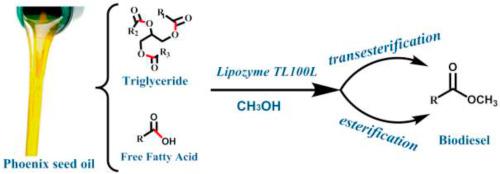Biomass & Bioenergy ( IF 5.8 ) Pub Date : 2020-12-13 , DOI: 10.1016/j.biombioe.2020.105930 Yanxia Zhou , Kaiyue Li , Shangde Sun

|
Biodiesel is a typical renewable and green energy, that is usually produced by the transesterification of edible vegetable oils. However, the cost of edible vegetable oils as feedstock accounts for 60%–80% of the total cost of biodiesel production. To overcome these issues, in this work, a low-cost feedstock, waste phoenix seed oil (PSO) with a high free fatty acid (FFA) content (30.1 ± 0.6%), consisting of the main fatty acid, linoleic acid (30.2%), oleic acid (22.2%), and palmitic acid (17.4%), was developed as a new feedstock to prepare biodiesel. A novel one-step method including simultaneous esterification of FFAs and transesterification of the PSO to prepare biodiesel was developed. Free lipase was used as catalyst. The influences of the reaction parameters were explored and optimized by response surface methodology. The results showed that the free lipase Lipozyme TL100L from Thermomyces lanuginosus can simultaneously catalyze esterification and transesterification. Under the optimum conditions (enzyme load 9.7%, reaction time 6.9 h, reaction temperature 31 °C and substrate ratio (methanol/PSO) 4.3: 1 (mol/mol)), the maximum biodiesel yield (93.8 ± 0.5%) was achieved. The activation energy from biodiesel preparation using PSO with a high FFA content was 39.7 kJ/mol. Furthermore, the kinetic values for K'm and Vmax were 0.18 mol/L and 0.043 mol/(L·min), respectively. The reaction mechanism of the simultaneous esterification and transesterification was also proposed. These results indicate that PSO with a high FFA content can be used as a potential feedstock for biodiesel production.
中文翻译:

使用游离脂肪酶催化剂同时对具有高游离脂肪酸含量的凤尾葵籽油进行酯化和酯交换反应,以制备生物柴油
生物柴油是一种典型的可再生绿色能源,通常通过食用植物油的酯交换反应产生。但是,食用植物油作为原料的成本占生物柴油生产总成本的60%–80%。为了克服这些问题,在这项工作中,使用了一种廉价原料,废凤凰种子油(PSO),其游离脂肪酸(FFA)含量高(30.1±0.6%),主要成分是亚油酸(30.2) ),油酸(22.2%)和棕榈酸(17.4%)被开发为制备生物柴油的新原料。开发了一种新颖的一步法,包括同时进行FFA酯化和PSO酯交换以制备生物柴油。游离脂肪酶用作催化剂。通过响应面法探索和优化了反应参数的影响。羊毛嗜热丝菌可同时催化酯化和酯交换。在最佳条件下(酶负载9.7%,反应时间6.9h,反应温度31°C和底物比(甲醇/ PSO)4.3:1(mol / mol)),获得了最大的生物柴油收率(93.8±0.5%) 。使用FFA含量高的PSO制备生物柴油的活化能为39.7 kJ / mol。此外,对于K”的动力学值米和V最大值分别为0.18摩尔/ L和0.043摩尔/(L·分钟),。还提出了同时酯化和酯交换的反应机理。这些结果表明,具有较高FFA含量的PSO可用作生产生物柴油的潜在原料。









































 京公网安备 11010802027423号
京公网安备 11010802027423号